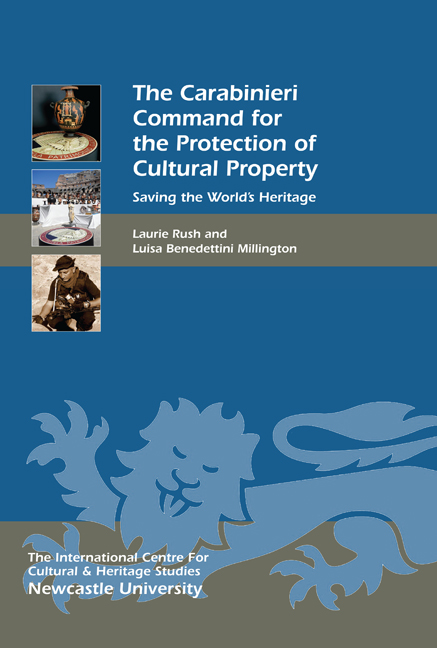Book contents
- Frontmatter
- Contents
- List of Illustrations
- Acknowledgments
- Foreword (in English and in Italian): Brigadier General Mariano Mossa
- Prefazione
- Abbreviations
- 1 The Carabinieri TPC: an Introduction and Brief History. Perché l’Italia? Why Italy?
- 2 Headquarters, the Databank and Operative Department in Rome
- 3 Carabinieri Public Outreach and Education
- 4 Central Italy and the Adriatic: Lazio, Florence, Bologna and Ancona
- 5 Activities in the North: Genova, Monza, Torino and Venezia
- 6 The Regional Offices: Naples, Bari and the South
- 7 The Challenges of the Island Regions: Sicily, Sardinia and the Palermo, Siracusa and Sassari Nuclei
- 8 Investigation Techniques
- 9 Repatriation of Works of Art to Italy: From Siviero to the Medici Conspiracy
- 10 Fakes, Forgeries and Money Laundering
- 11 Who Are the Officers of the Carabinieri TPC?
- 12 The Carabinieri, Peacekeeping and Foreign Relations: The Carabinieri Mission to Iraq
- 13 ‘The Italian Model’
- Bibliography and References
- About the Authors
- Index
- Heritage Matters
13 - ‘The Italian Model’
Published online by Cambridge University Press: 21 May 2021
- Frontmatter
- Contents
- List of Illustrations
- Acknowledgments
- Foreword (in English and in Italian): Brigadier General Mariano Mossa
- Prefazione
- Abbreviations
- 1 The Carabinieri TPC: an Introduction and Brief History. Perché l’Italia? Why Italy?
- 2 Headquarters, the Databank and Operative Department in Rome
- 3 Carabinieri Public Outreach and Education
- 4 Central Italy and the Adriatic: Lazio, Florence, Bologna and Ancona
- 5 Activities in the North: Genova, Monza, Torino and Venezia
- 6 The Regional Offices: Naples, Bari and the South
- 7 The Challenges of the Island Regions: Sicily, Sardinia and the Palermo, Siracusa and Sassari Nuclei
- 8 Investigation Techniques
- 9 Repatriation of Works of Art to Italy: From Siviero to the Medici Conspiracy
- 10 Fakes, Forgeries and Money Laundering
- 11 Who Are the Officers of the Carabinieri TPC?
- 12 The Carabinieri, Peacekeeping and Foreign Relations: The Carabinieri Mission to Iraq
- 13 ‘The Italian Model’
- Bibliography and References
- About the Authors
- Index
- Heritage Matters
Summary
‘The Italian Model’ proposes examples for every aspect of saving cultural heritage, academic partnership, law enforcement, application of international law, investigation techniques, military deployment capability, protection of archaeological sites, collections security, public outreach and successful repatriation. One needs only to look again at the statistics to see that the model is working. If we consider the 1999–2011 period, we observe a steady decline in the number of art thefts from Italy, from over 2000 in 1999 to under 1000 in 2011. Between 2004 and 2011 there was a decrease in reported episodes of illicit archaeological excavation (looting) from approximately 250 per year to approximately 50; and between 2006 and 2011 an overall increase in archaeological objects recovered, rising from 26,649 in 2006 to 35,727 in 2011. In 2008 and 2010, the Carabinieri TPC recovered over 44,000 artefacts (Marín-Aguilera 2012, 570–1).
In 2007 The Associated Press ran a story titled ‘Soon, tombaroliwill be hard to find’ (David 2007). The Commander of the Carabinieri TPC told the reporter that in the late 1990s TPC officers might encounter over 1000 illicit archaeological excavations, in contrast to the 40 encountered in 2006. The successful repatriation of objects from the US to Italy has also served to warn the art market that the purchase of illegal objects from Italy is no longer without risk. Art dealers, museums and collectors are paying much more attention to the provenance documentation of objects appearing on the market, thereby making it much more difficult for the average tombarolito find an enthusiastic buyer. Mr David also quotes the well-known tombaroloPietro Casasanta, whose looting career was also discussed previously in Chapter 4, who provided a first-hand account of the differences in enforcement that he had experienced over time. ‘Nobody cared, and there was so much money going around’, he recalled. ‘I always worked during the day, with the same hours as construction crews, because at night it was easier to get noticed and to make mistakes.’ Mr Casasanta actually used bulldozers when looting Roman villas – his favourite type of site. When he began looting in the 1950s, he was able to sell the objects he found on market stalls in Rome that openly sold antiquities. He lamented to Mr David that, 50 years on, young people were no longer interested in learning to become tombaroliand that ‘the whole network of merchants has disappeared’.
- Type
- Chapter
- Information
- The Carabinieri Command for the Protection of Cultural PropertySaving the World's Heritage, pp. 175 - 182Publisher: Boydell & BrewerPrint publication year: 2015



